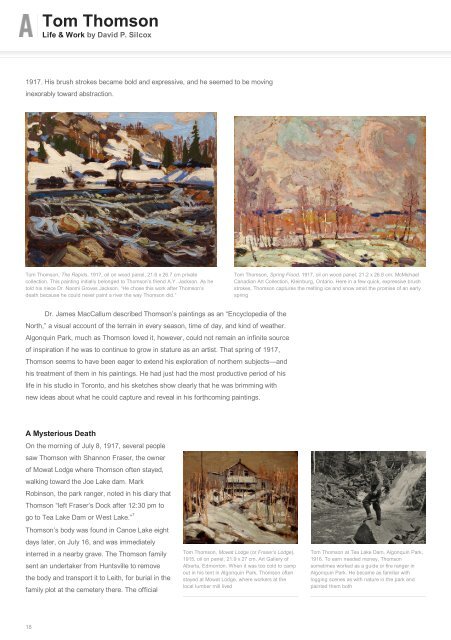Create successful ePaper yourself
Turn your PDF publications into a flip-book with our unique Google optimized e-Paper software.
<strong>Tom</strong> <strong>Thomson</strong><br />
Life & Work by David P. Silcox<br />
1917. His brush strokes became bold and expressive, and he seemed to be moving<br />
inexorably toward abstraction.<br />
<strong>Tom</strong> <strong>Thomson</strong>, The Rapids, 1917, oil on wood panel, 21.6 x 26.7 cm private<br />
collection. This painting initially belonged to <strong>Thomson</strong>’s friend A.Y. Jackson. As he<br />
told his niece Dr. Naomi Groves Jackson, “He chose this work after <strong>Thomson</strong>’s<br />
death because he could never paint a river the way <strong>Thomson</strong> did.”<br />
<strong>Tom</strong> <strong>Thomson</strong>, Spring Flood, 1917, oil on wood panel, 21.2 x 26.8 cm, McMichael<br />
Canadian Art Collection, Kleinburg, Ontario. Here in a few quick, expressive brush<br />
strokes, <strong>Thomson</strong> captures the melting ice and snow amid the promise of an early<br />
spring<br />
Dr. James MacCallum described <strong>Thomson</strong>’s paintings as an “Encyclopedia of the<br />
North,” a visual account of the terrain in every season, time of day, and kind of weather.<br />
Algonquin Park, much as <strong>Thomson</strong> loved it, however, could not remain an infinite source<br />
of inspiration if he was to continue to grow in stature as an artist. That spring of 1917,<br />
<strong>Thomson</strong> seems to have been eager to extend his exploration of northern subjects—and<br />
his treatment of them in his paintings. He had just had the most productive period of his<br />
life in his studio in Toronto, and his sketches show clearly that he was brimming with<br />
new ideas about what he could capture and reveal in his forthcoming paintings.<br />
A Mysterious Death<br />
On the morning of July 8, 1917, several people<br />
saw <strong>Thomson</strong> with Shannon Fraser, the owner<br />
of Mowat Lodge where <strong>Thomson</strong> often stayed,<br />
walking toward the Joe Lake dam. Mark<br />
Robinson, the park ranger, noted in his diary that<br />
<strong>Thomson</strong> “left Fraser’s Dock after 12:30 pm to<br />
go to Tea Lake Dam or West Lake.”<br />
<strong>Thomson</strong>’s body was found in Canoe Lake eight<br />
days later, on July 16, and was immediately<br />
interred in a nearby grave. The <strong>Thomson</strong> family<br />
sent an undertaker from Huntsville to remove<br />
the body and transport it to Leith, for burial in the<br />
family plot at the cemetery there. The official<br />
7<br />
<strong>Tom</strong> <strong>Thomson</strong>, Mowat Lodge (or Fraser’s Lodge),<br />
1915, oil on panel, 21.9 x 27 cm, Art Gallery of<br />
Alberta, Edmonton. When it was too cold to camp<br />
out in his tent in Algonquin Park, <strong>Thomson</strong> often<br />
stayed at Mowat Lodge, where workers at the<br />
local lumber mill lived<br />
<strong>Tom</strong> <strong>Thomson</strong> at Tea Lake Dam, Algonquin Park,<br />
1916. To earn needed money, <strong>Thomson</strong><br />
sometimes worked as a guide or fire ranger in<br />
Algonquin Park. He became as familiar with<br />
logging scenes as with nature in the park and<br />
painted them both<br />
18


